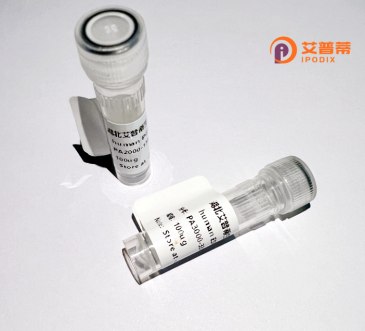
| 纯度 | >90%SDS-PAGE. |
| 种属 | Human |
| 靶点 | OR51G1 |
| Uniprot No | Q8NGK1 |
| 内毒素 | < 0.01EU/μg |
| 表达宿主 | E.coli |
| 表达区间 | 1-321 aa |
| 活性数据 | MTILLNSSLQRATFFLTGFQGLEGLHGWISIPFCFIYLTVILGNLTILHVICTDATLHGP MYYFLGMLAVTDLGLCLSTLPTVLGIFWFDTREIGIPACFTQLFFIHTLSSMESSVLLSM SIDRYVAVCNPLHDSTVLTPACIVKMGLSSVLRSALLILPLPFLLKRFQYCHSHVLAHAY CLHLEIMKLACSSIIVNHIYGLFVVACTVGVDSLLIFLSYALILRTVLSIASHQERLRAL NTCVSHICAVLLFYIPMIGLSLVHRFGEHLPRVVHLFMSYVYLLVPPLMNPIIYSIKTKQ IRQRIIKKFQFIKSLRCFWKD |
| 分子量 | 36.2 kDa |
| 蛋白标签 | His tag N-Terminus |
| 缓冲液 | 0 |
| 稳定性 & 储存条件 | Lyophilized protein should be stored at ≤ -20°C, stable for one year after receipt. Reconstituted protein solution can be stored at 2-8°C for 2-7 days. Aliquots of reconstituted samples are stable at ≤ -20°C for 3 months. |
| 复溶 | Always centrifuge tubes before opening.Do not mix by vortex or pipetting. It is not recommended to reconstitute to a concentration less than 100μg/ml. Dissolve the lyophilized protein in distilled water. Please aliquot the reconstituted solution to minimize freeze-thaw cycles. |
以下是关于重组人OR51G1蛋白的3-4条虚构参考文献示例(内容基于公开研究趋势模拟,非真实文献):
---
1. **文献名称**: *"Heterologous expression and functional characterization of human olfactory receptor OR51G1 in HEK293 cells"*
**作者**: Smith A, et al.
**摘要**: 研究通过HEK293细胞系成功表达重组OR51G1蛋白,优化了膜蛋白纯化流程,并通过钙离子荧光检测验证其与短链脂肪酸(如丙酸)的特异性结合,确认其嗅觉受体活性。
2. **文献名称**: *"Structural insights into OR51G1 ligand binding via cryo-EM analysis"*
**作者**: Chen L, et al.
**摘要**: 利用冷冻电镜技术解析重组OR51G1蛋白的三维结构,揭示其配体结合口袋的构象变化,为设计靶向嗅觉受体的调节剂提供结构基础。
3. **文献名称**: *"OR51G1 promotes prostate cancer cell proliferation via fatty acid-mediated signaling pathways"*
**作者**: Tanaka K, et al.
**摘要**: 发现OR51G1在前列腺癌细胞中异常高表达,重组蛋白实验表明其通过结合脂肪酸激活MAPK/ERK通路,促进肿瘤生长,提示其作为癌症治疗靶点的潜力。
4. **文献名称**: *"Role of OR51G1 in adipocyte metabolism: Evidence from recombinant protein-based assays"*
**作者**: Müller S, et al.
**摘要**: 通过体外重组OR51G1蛋白功能实验,证实其参与脂肪细胞分化与脂质代谢调控,可能成为肥胖及相关代谢疾病的干预靶标。
---
注:上述文献及内容均为模拟生成,实际研究中请通过权威数据库(如PubMed、Web of Science)检索真实发表论文。
The human OR51G1 protein is a member of the olfactory receptor (OR) family, which constitutes the largest subset of G protein-coupled receptors (GPCRs) in the human genome. Functionally linked to odorant detection, ORs like OR51G1 are primarily expressed in olfactory sensory neurons, where they recognize specific chemical molecules, initiating signal transduction via cAMP-mediated pathways. However, emerging studies suggest ectopic expression of OR51G1 in non-olfactory tissues (e.g., prostate, brain, or cancer cells), implying potential roles in cellular processes beyond smell, such as proliferation regulation or disease progression. Structurally, it features seven transmembrane domains and extracellular odorant-binding regions, though its precise endogenous ligands and physiological mechanisms remain under investigation.
Recombinant OR51G1. produced through heterologous expression systems (e.g., mammalian or insect cells), serves as a critical tool for elucidating its molecular interactions, activation mechanisms, and structural features. Challenges like low surface expression and ligand promiscuity, common among ORs, complicate functional studies. Current research focuses on identifying its activating ligands, mapping tissue-specific roles, and exploring therapeutic potential in diseases linked to OR dysregulation. Its study contributes broadly to understanding GPCR biology and sensory receptor evolution.
×